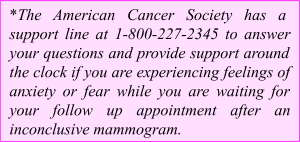What is a false-positive mammogram?
You get your mammogram. You go home. You get a call asking you to schedule a follow up mammogram. What now?! You are a bit worried, race to Dr. Google for some advice. Dr. Google does a great job of providing you with every worst-case scenario. Your anxiety is up. And then it turns out it was dense breast tissue, a small calcification, or a benign biopsy--not breast cancer.
 Most of the time, when the radiologist sees "something" on your mammogram and they call you back in to have a closer look, or take a biopsy, it will turn out to be a "false positive." In fact, about 80% of breast biopsies conducted are benign (that means they are not cancerous). If you and your best friend got mammograms together every year for ten years in a row, chances are one of you will have a false positive mammogram at least once!1 So, it's fairly common to have a false positive mammogram.
Most of the time, when the radiologist sees "something" on your mammogram and they call you back in to have a closer look, or take a biopsy, it will turn out to be a "false positive." In fact, about 80% of breast biopsies conducted are benign (that means they are not cancerous). If you and your best friend got mammograms together every year for ten years in a row, chances are one of you will have a false positive mammogram at least once!1 So, it's fairly common to have a false positive mammogram.
What does this actually mean to your breast cancer risk? Well, having a false positive mammogram does slightly increase your risk of developing breast cancer.2 (At least for ten years following that false-positive event.)
The image from your false-positive mammogram showed something that made your doctor think twice; this happens a lot in women who have dense breast tissue because the dense tissue often looks mistakenly similar to the way a small tumor might appear in the image. A tumor can more easily hide in dense breast tissue. This is one of the reasons that having dense breast tissue can increase your risk of breast cancer.3
After a false positive event, we don't want you to be anxious about your risk of developing breast cancer. We want you to be aware of your risks, and feel confident that you are taking the steps you need in order to reduce your risk. Talk to your healthcare provider about your risk. There are loads of other risk factors that influence your risk of developing breast cancer. And there is no magic combination. Don't be shy about asking your healthcare provider a question. There aren't any stupid questions when it comes to your health. And finally, remember to listen to your body…you are your own best advocate.
- Hubbard RA, Kerlikowske K, Flowers CI, Yankaskas BC, Zhu W, Miglioretti DL. Cumulative probability of false-positive recall or biopsy recommendation after 10 years of screening mammography: a cohort study. Ann Intern Med. 2011;155(8):481-92.
- Henderson LM, Hubbard, RA Sprague BL, Zhu W, Kerlikowske K. Increased Risk of Developing Breast Cancer after a False-Positive Screening Mammogram. Cancer Epidemiol Biomarkers Prev. 2015;24(12) 1882-1889,.
- Holland K, van Gils CH, Mann RM, Karssemeijer N. Quantification of masking risk in screening mammography with volumetric breast density maps. Breast Cancer Res Treat. 2017;162(3):541-548.
This cartoon was published in "The Record of Hackensack", in New Jersey, on 11/20/2009. In mammogram screening guidelines put forth by the US Preventative Services Task Force, one "harm" of screening includes the anxiety of false positive results, and for this reason, they do not recommend screening between 40-49. However, the benefit is actually saving a woman's life through early detection. When asked, most women feel that saving one women's life is worth a few thousand false positives.

